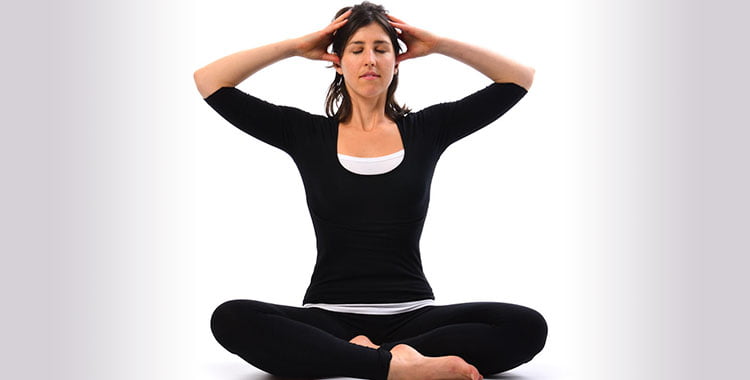How to do Bhramari Pranayama, Humming Bee Breath
Bhramari Pranayama – Humming Bee Breath lets us listen inwardly to the sound of our own breath which is deeply restorative. This practice calms the emotions. It relieves anger or anxiety because it reconnects us to the nurturing rhythmic pulsation within our own being. Regular practice instantly increases our sense of well-being.

Simple Bhramari with Shanmukhi Mudra (hands position)
Use your thumbs to gently push on the tragus of each ear—the bump of cartilage on the cheek side—to block the ear canal.
2. Close the eyes and bring your attention inward to the belly, the heart, the throat, and then the head. Inhale slowly to a comfortable fullness. When you come to exhale make a humming sound in the pallet of the mouth. This is one round. Repeat for 10 rounds or continue for several minutes.
3. Since your exhalation is now considerably lengthened, it is important to inhale unhurriedly. Don’t rush into the next exhalation but take your time as you slowly fill the lungs with air.

Traditional Bhramari with Shanmukhi Mudra (hands position)
Place one thumb on each tragus, the index fingers lightly touching the inner corners of your eyes, the middle fingers on the sides of the nose, the ring fingers above the lips, and the little fingers just below. Be sure to place only very light pressure on the eyes.
5. Sit quietly when you are finished. Keep your eyes closed. You may observe the sensations of the sound vibration pulsing through your body for some time. Move a muscle! The stiller you sit, the deeper your powers of observation.
Tip
If you suffer from anxiety, depression, or claustrophobia, you may not enjoy the Traditional Shanmukhi Mudra hands position. You may find the Simple variation more relaxing.
Benefits of Bhramari Pranayama
Bhramari, a safe, easy-to-learn practice, has tremendous therapeutic potential. Like other pranayamas, its power comes partly from its effects on the autonomic nervous system (ANS). Lengthening the exhalation relative to the inhalation activates the calming parasympathetic branch of the ANS. For those who suffer from anxiety or anxious (rajasic) depression, the practice can begin to quiet the mind within a few breaths. The noise of bhramari’s incessant buzzing can drown out the endless mental tape loops that can fuel emotional suffering, at least for a few minutes, making it a useful starting point for those whose minds are too “busy” to meditate.

